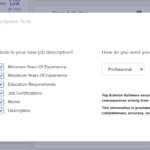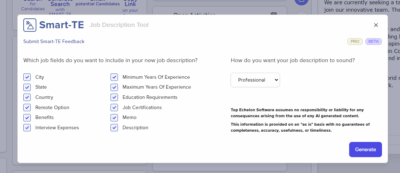In today’s highly competitive talent landscape, speed is often the difference between success and failure in recruitment. Top candidates are in high demand, and companies are racing to secure the best talent before their competitors. As a result, the traditional, time-consuming vetting process can no longer keep pace with modern recruitment needs. Agency recruiters and search consultants must find ways to accelerate the candidate vetting process without sacrificing quality to increase placements and satisfy both clients and candidates.
This article from Top Echelon Recruiting Software explores strategies and tools to help agency recruiters and search consultants streamline the vetting process, increase efficiency, and ensure timely placements. From leveraging technology to enhancing communication and refining the interview process, we’ll cover actionable ways to shorten the candidate vetting cycle while maintaining high standards.
1. Leverage Technology to Speed Up Candidate Screening
Technology is a game-changer in recruitment, particularly when it comes to candidate vetting. By incorporating advanced tools into your process, you can drastically reduce the time spent on manual tasks and ensure a more efficient workflow.
- AI-Powered Resume Screening: Automated resume screening tools, powered by artificial intelligence (AI), can help recruiters quickly sift through hundreds or even thousands of resumes to find the most qualified candidates. These tools scan resumes for keywords, relevant skills, and experience, allowing recruiters to focus on top-tier candidates rather than manually reviewing every application.
- Applicant Tracking Systems (ATS): An ATS can help manage the entire recruitment pipeline, from sourcing to screening, in one centralized platform. ATS tools can automatically rank candidates based on predefined criteria, notify you when top candidates are identified, and even schedule interviews.
- Video Interview Platforms: Video interviews can accelerate the vetting process by allowing recruiters to assess candidates remotely and quickly. Video platforms often offer features like pre-recorded interviews, enabling candidates to answer a set of questions at their convenience. Recruiters can review these responses at any time, significantly reducing the time spent coordinating live interviews.
Key takeaway: Automate where possible. Invest in AI-powered tools and an ATS to quickly identify qualified candidates and cut down on manual screening tasks.
2. Standardize the Vetting Process
One of the most effective ways to accelerate candidate vetting is to create a standardized process. By defining a clear, repeatable vetting framework, recruiters can streamline decision-making, eliminate unnecessary steps, and ensure consistency across all candidates.
- Create a Candidate Scorecard: Develop a candidate scorecard that outlines the key criteria for each role, including skills, qualifications, and experience. This allows you to objectively evaluate candidates against a standardized set of metrics, making it easier to identify the top prospects quickly.
- Use Structured Interview Formats: Structured interviews ensure that all candidates are evaluated on the same set of questions, allowing for faster comparisons and more objective assessments. This format also helps to reduce bias, ensuring that decisions are based on consistent criteria.
- Pre-define Knockout Questions: During initial screening, use a set of knockout questions that instantly determine whether a candidate meets the basic requirements for the role. For example, if a job requires specific certifications or language proficiency, candidates who fail to meet those criteria can be disqualified early in the process.
Key takeaway: Standardize your vetting process with clear criteria and structured interviews to ensure consistency and reduce the time spent evaluating candidates.
3. Pre-Screen Candidates Before Submitting Them to Clients
Many recruiters waste time submitting candidates to clients without fully understanding whether they are a good fit for the role. By pre-screening candidates thoroughly before presenting them to clients, you can improve the quality of submissions and increase your placement success rate.
- Conduct Pre-Screening Calls: A quick pre-screening call can help confirm a candidate’s interest in the role, their qualifications, and their availability. This step allows recruiters to address any potential red flags early on and saves time by avoiding candidates who may not be committed or well-suited for the job.
- Verify Skills with Assessments: Use online skills assessments or technical tests to verify a candidate’s qualifications before submitting them to the client. This ensures that candidates not only have the necessary experience but also the practical skills required for the position.
- Cultural Fit and Alignment: Evaluate the candidate’s fit within the company’s culture during the pre-screening process. Asking targeted questions about work preferences, values, and collaboration style can help you assess whether a candidate will thrive in the client’s work environment.
Key takeaway: Pre-screen candidates with assessments, calls, and cultural fit evaluations to ensure they meet the client’s requirements, reducing the time wasted on unqualified candidates.
4. Streamline Client Communication and Feedback
Client feedback often becomes a bottleneck in the vetting process, leading to delays in moving candidates forward. To speed up the process, recruiters need to establish a streamlined communication channel with their clients, ensuring that feedback is timely and actionable.
- Set Clear Expectations: When starting a new search, set clear expectations with clients about response times and the feedback process. Agree on a timeline for reviewing candidates and establish a communication protocol for quick decisions.
- Use Feedback Templates: Provide clients with a structured feedback form or template to make it easier for them to provide specific and timely feedback on candidates. By standardizing the feedback process, you can avoid ambiguous responses and help clients make faster decisions.
- Implement Regular Check-ins: Schedule regular check-ins with your clients to review the status of candidates and any feedback that has been provided. This ensures that candidates aren’t left waiting for extended periods and that the process continues to move forward.
Key takeaway: Establish clear communication protocols and use structured feedback templates to ensure clients provide timely and actionable feedback on candidates.
5. Leverage Data and Analytics to Make Informed Decisions
Recruiters can significantly accelerate the candidate vetting process by leveraging data and analytics to make informed, evidence-based decisions. Using data can help you predict candidate success, identify red flags, and streamline the selection process.
- Candidate Matching Algorithms: Many ATS platforms and AI-driven tools offer candidate matching algorithms that can predict a candidate’s likelihood of success in a given role. By analyzing past placements, skills, and job performance, these tools can help you quickly identify candidates who are most likely to succeed.
- Track Key Performance Metrics: Use data to track key performance indicators (KPIs) related to your vetting process. Metrics like time-to-fill, candidate drop-off rates, and client satisfaction can provide valuable insights into areas where the process can be optimized for speed.
- Analyze Past Hiring Trends: Look at historical hiring data to identify patterns that can inform your current search. For example, if certain types of candidates have consistently succeeded in similar roles, prioritize those profiles in your current search to accelerate the process.
Key takeaway: Use data and analytics to make informed decisions and optimize your vetting process based on past trends and predictive insights.
6. Enhance Candidate Engagement and Communication
Speeding up the candidate vetting process doesn’t just involve your internal workflow. It’s also crucial to ensure that candidates are fully engaged and responsive throughout the process. When candidates feel valued and informed, they are more likely to stay in the process and move quickly through the stages.
- Maintain Open Communication Channels: Keep candidates informed about the status of their application, next steps, and timelines. Regular communication helps to maintain their interest and prevents them from disengaging or accepting other offers during the process.
- Fast-Track High-Potential Candidates: For top-tier candidates who are in high demand, fast-track them through the vetting process. This may involve scheduling interviews sooner, providing immediate feedback, and offering accelerated decision-making timelines to keep them engaged.
- Provide a Personalized Candidate Experience: Candidates appreciate a personalized experience, where they feel like more than just a number in a database. Tailor your communication to address the candidate’s specific interests and motivations to keep them engaged and moving forward.
Key takeaway: Ensure that candidates remain engaged and informed throughout the process by maintaining open communication and providing a personalized experience.
7. Outsource or Delegate Where Possible
Recruitment agencies and search consultants often deal with multiple open roles, each with its own set of candidates. Managing this workload can slow down the vetting process. To avoid this, consider outsourcing or delegating certain tasks to free up time for more critical, high-impact activities.
- Delegate Administrative Tasks: Outsource or delegate administrative tasks such as background checks, reference checks, and data entry to other team members or third-party vendors. This allows recruiters to focus on higher-level tasks like interviews and candidate evaluations.
- Outsource Skill Testing: For technical or specialized roles, consider outsourcing skill testing to a third-party assessment platform. This ensures that candidates’ skills are properly evaluated without taking up valuable time in-house.
- Use Recruitment Process Outsourcing (RPO): If your agency is overwhelmed with high-volume hiring, consider using an RPO provider to manage parts of the vetting process. RPO firms specialize in handling large-scale recruitment and can help speed up the process for your team.
Key takeaway: Outsource or delegate time-consuming tasks to free up resources and focus on high-impact activities that move candidates through the pipeline faster.
8. Refine the Interview Process for Efficiency
Interviews are one of the most time-intensive parts of the vetting process. To speed up this step without sacrificing quality, recruiters should refine their interview process and introduce strategies that minimize delays.
- Combine Interview Stages: Instead of scheduling multiple rounds of interviews, combine stages where possible. For example, you could hold a technical interview and a cultural fit interview on the same day to reduce the number of meetings candidates need to attend.
- Use Panel Interviews: Conducting panel interviews, where several interviewers assess the candidate at once, can speed up the process by consolidating multiple interviews into a single session. This approach allows for faster feedback and decision-making.
- Create Shortlists for Interviews: Rather than interviewing every candidate who meets the minimum requirements, create a shortlist of the most promising candidates for interviews. This ensures that you’re focusing your time on the best prospects and moving quickly through the vetting process.
Key takeaway: Streamline the interview process by combining stages, using panel interviews, and focusing only on top candidates for in-depth interviews.
9. Build a Pre-Vetted Talent Pipeline
One of the most effective ways to speed up the candidate vetting process is to build a pre-vetted talent pipeline. This means continuously sourcing, engaging, and pre-screening candidates for roles that are frequently open, so you always have a pool of qualified candidates ready to go when a new job order comes in.
- Create Talent Pools for Key Roles: For roles that are always in demand, such as software developers or sales executives, build talent pools of pre-vetted candidates. These candidates can be quickly contacted and presented to clients when a matching opportunity arises.
- Maintain Relationships with Passive Candidates: Stay in touch with passive candidates who may not be actively looking for a new role but would consider one in the future. Keeping them engaged and informed means they can be fast-tracked when the right opportunity arises.
- Nurture Silver Medalists: Candidates who were runners-up in previous searches, also known as “silver medalists,” are great additions to your talent pipeline. They’ve already been through the vetting process, so when the next opportunity arises, you can move quickly.
Key takeaway: Build and maintain a pre-vetted talent pipeline to ensure you always have qualified candidates ready for quick placements.
In the fast-paced world of recruitment, the ability to accelerate the candidate vetting process without compromising on quality is essential for making more placements and staying ahead of the competition. By leveraging technology, standardizing your vetting process, improving communication, and refining interview techniques, recruiters can reduce the time spent on each step and ensure faster, more efficient placements.
Ultimately, success in modern recruitment depends on balancing speed with precision. By following the strategies outlined in this article, agency recruiters and search consultants can streamline their workflows, reduce bottlenecks, and make more placements in a shorter amount of time.








